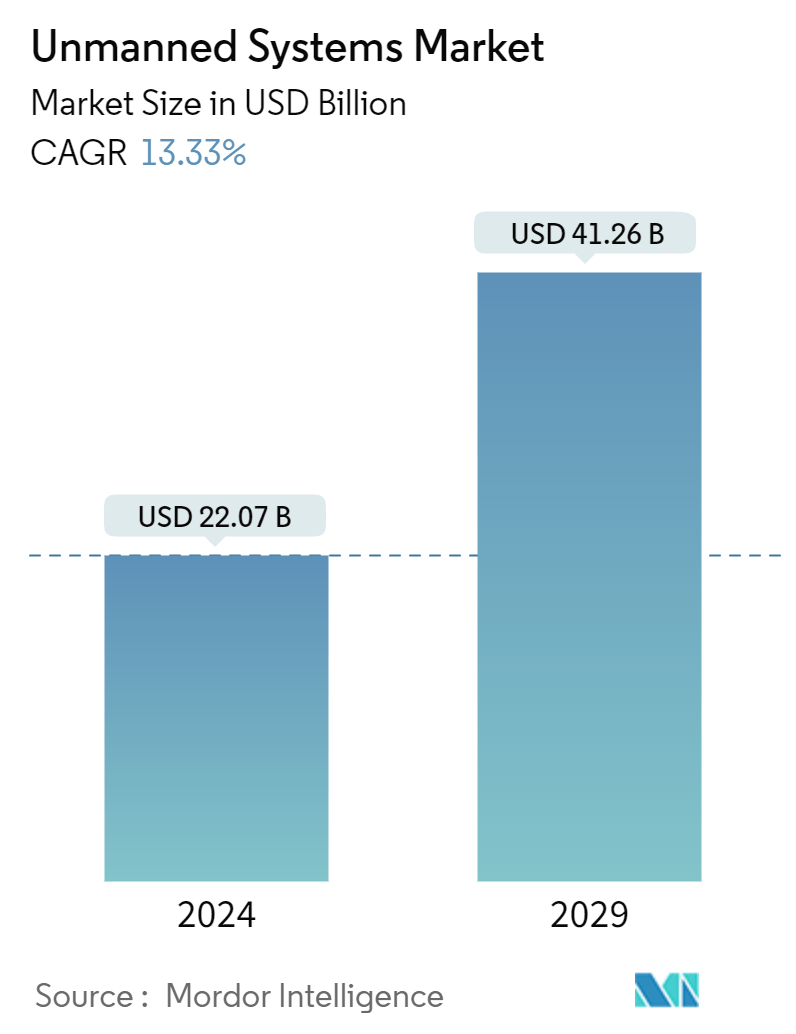Market Size of Unmanned Systems Industry

| Study Period | 2019 - 2029 |
| Market Size (2024) | USD 22.07 Billion |
| Market Size (2029) | USD 41.26 Billion |
| CAGR (2024 - 2029) | 13.33 % |
| Fastest Growing Market | Asia Pacific |
| Largest Market | North America |
| Market Concentration | Low |
Major Players
*Disclaimer: Major Players sorted in no particular order |
Unmanned Systems Market Analysis
The Unmanned Systems Market size is estimated at USD 22.07 billion in 2024, and is expected to reach USD 41.26 billion by 2029, growing at a CAGR of 13.33% during the forecast period (2024-2029).
Increasing global defense expenditures, a focus on strengthening defense forces, and the growing use of unmanned systems for intelligence, surveillance, and reconnaissance (ISR) and combat missions drive the market's growth. Defense forces are highly invested in developing and procuring unmanned systems over manned systems as they reduce the risks of soldier casualties and enhance accuracy during combat operations.
The growing use of unmanned systems in the commercial sectors, such as unmanned ground vehicles (UGVs) in firefighting and agriculture, unmanned sea vehicles (USVs) for underwater sea exploration and marine research, and unmanned aerial vehicles (UAVs) for disaster relief, recreational uses, and photo and videography, will boost the market growth.
However, the lack of regulations and restrictions on flying drones beyond the visual line of sight in several countries worldwide has restrained the market's growth. Other factors, such as safety and security concerns and the scarcity of trained pilots, are also anticipated to challenge the market's growth to a certain extent.
Unmanned Systems Industry Segmentation
Unmanned systems are autonomous or remotely controlled systems used for various applications, from military and defense to homeland security. They are used in all airborne, land, and naval platforms. Major applications include underwater surveys, intelligence, surveillance, reconnaissance (ISR), border patrol, and other combat operations.
The unmanned systems market is segmented by type, application, and geography. By type, it is divided into unmanned aerial vehicles (UAVs), unmanned ground vehicles (UGVs), and unmanned sea vehicles (USVs). By application, it is classified into military, law enforcement, and commercial. The report also covers the market sizes and forecasts for unmanned systems in major countries across different regions. For each segment, the market size is provided in terms of value (USD).
| Type | ||||||
| ||||||
| ||||||
|
| Application | |
| Military and Law Enforcement | |
| Commercial |
| Geography | |||||||
| |||||||
| |||||||
| |||||||
| |||||||
|
Unmanned Systems Market Size Summary
The unmanned systems market is poised for significant expansion, driven by increasing global defense expenditures and a strategic shift towards unmanned systems for intelligence, surveillance, reconnaissance, and combat missions. This transition is largely due to the enhanced operational efficiency and reduced risk to personnel that unmanned systems offer compared to traditional manned systems. The commercial sector is also witnessing a surge in the adoption of unmanned systems, with applications ranging from agriculture and firefighting to marine research and disaster relief. Despite these growth drivers, the market faces challenges such as regulatory hurdles, safety concerns, and a shortage of trained operators, which could potentially impede its progress.
Regionally, Asia-Pacific is expected to experience robust growth, fueled by substantial investments from countries like China, India, and Japan in unmanned systems. This growth is supported by increased defense spending and favorable regulations for commercial applications. The market is characterized by fragmentation, with numerous suppliers offering a variety of unmanned platforms. Key players such as Lockheed Martin, BAE Systems, and Northrop Grumman are leveraging product innovation and strategic mergers to expand their market presence and diversify their offerings. The ongoing development and procurement of advanced unmanned systems in response to geopolitical tensions further bolster the market's growth prospects.
Unmanned Systems Market Size - Table of Contents
-
1. MARKET DYNAMICS
-
1.1 Market Overview
-
1.2 Market Drivers
-
1.3 Market Restraints
-
1.4 Porter's Five Forces Analysis
-
1.4.1 Bargaining Power of Buyers/Consumers
-
1.4.2 Bargaining Power of Suppliers
-
1.4.3 Threat of New Entrants
-
1.4.4 Threat of Substitute Products
-
1.4.5 Intensity of Competitive Rivalry
-
-
-
2. MARKET SEGMENTATION
-
2.1 Type
-
2.1.1 Unmanned Aerial Vehicles
-
2.1.1.1 Small UAVs
-
2.1.1.2 Medium UAVs
-
2.1.1.3 Large UAVs
-
-
2.1.2 Unmanned Ground Vehicles
-
2.1.2.1 Wheeled
-
2.1.2.2 Tracked
-
2.1.2.3 Legged
-
2.1.2.4 Hybrid
-
-
2.1.3 Unmanned Sea Systems
-
2.1.3.1 Unmanned Underwater Vehicles (UUVs)
-
2.1.3.2 Unmanned Surface Vehicles (USVs)
-
-
-
2.2 Application
-
2.2.1 Military and Law Enforcement
-
2.2.2 Commercial
-
-
2.3 Geography
-
2.3.1 North America
-
2.3.1.1 United States
-
2.3.1.2 Canada
-
-
2.3.2 Europe
-
2.3.2.1 Germany
-
2.3.2.2 United Kingdom
-
2.3.2.3 France
-
2.3.2.4 Russia
-
2.3.2.5 Rest of Europe
-
-
2.3.3 Asia-Pacific
-
2.3.3.1 China
-
2.3.3.2 India
-
2.3.3.3 South Korea
-
2.3.3.4 Japan
-
2.3.3.5 Rest of Asia-Pacific
-
-
2.3.4 Latin America
-
2.3.4.1 Brazil
-
2.3.4.2 Rest of Latin America
-
-
2.3.5 Middle East and Africa
-
2.3.5.1 United Arab Emirates
-
2.3.5.2 Saudi Arabia
-
2.3.5.3 Rest of Middle East and Africa
-
-
-
Unmanned Systems Market Size FAQs
How big is the Unmanned Systems Market?
The Unmanned Systems Market size is expected to reach USD 22.07 billion in 2024 and grow at a CAGR of 13.33% to reach USD 41.26 billion by 2029.
What is the current Unmanned Systems Market size?
In 2024, the Unmanned Systems Market size is expected to reach USD 22.07 billion.

